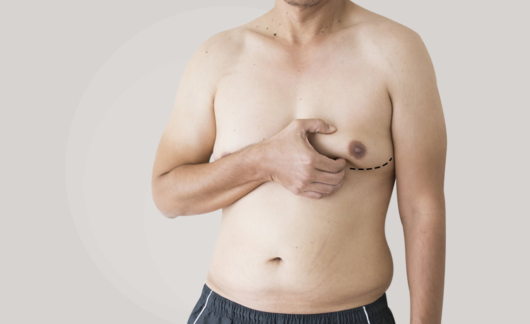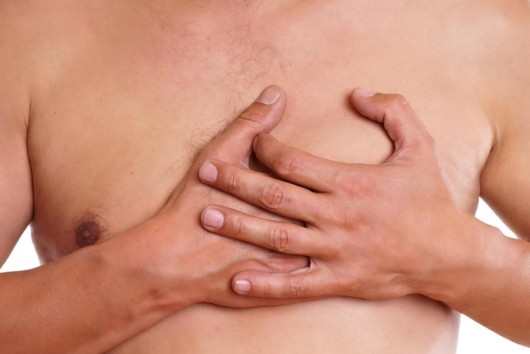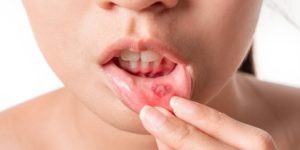Gynecomastia is male breast enlargement usually caused by a hormone imbalance when the levels of estrogen (female hormone) are too high and testosterone (male hormone) levels are too low. This often happens during puberty and typically resolves within two to three years. Gynecomastia symptoms are more common in men over 60 when hormone changes occur during male menopause (andropause).
Other causes of gynecomastia can include:
- Prescription medications
- Liver and kidney disease
- Tumors (cancer)
- Marijuana (cannabis) use
- Anabolic steroids
- Klinefelter syndrome.
Gynecomastia Overview
Gynecomastia refers to the growth of breast glandular tissue, which results in the development of enlarged male breasts. In some cases, this is accompanied by excess fatty tissue and skin, giving the appearance of female breasts.

Gynecomastia has been categorized by the American Association of Plastic Surgeons into four different grades, as below:
- Grade 1 is a slight enlargement, which usually presents with puffy-looking nipples.
- Grade 2 is mild to moderate enlargement, normally a combination of glandular and fatty tissue.
- Grade 3 is moderate to significant enlargement, with a combination of glandular tissue and fatty tissue and excess skin causing a noticeable breast crease.
- Grade 4 is severe enlargement with a combination of glandular tissue and fatty tissue, and excess skin causing the appearance of a full breast with a deep breast crease.
What Is the Difference Between Gynecomastia and Pseudogynecomastia Symptoms?
True gynecomastia causes the growth of breast glandular tissue and will usually present with a small disc of firm tissue beneath the nipple. Enlarged male breasts caused by true gynecomastia will often feel firmer and may also be tender to touch.
Pseudogynecomastia consists entirely of fatty tissue, which is softer and more pliable than breast glandular tissue. Man boobs caused by pseudogynecomastia will not usually feel tender and will fluctuate when weight is gained or lost.
A plastic surgeon can diagnose if your gynecomastia symptoms are due to true gynecomastia or pseudogynecomastia during a physical examination.
What Is Male Breast Cancer?
Men often worry that gynecomastia symptoms could indicate breast cancer. Male breast cancer is rare and occurs most often in men over 60. Treatment involves the removal of breast glandular tissue. Some men may also require radiotherapy and chemotherapy. If you are worried about male breast cancer, medical imaging can be performed to evaluate the anatomical and physiological properties of tissue.

Symptoms of male breast cancer include:
- Enlargement of glandular tissue, which feels firm or can appear as a lump
- Dimpling, puckering, and redness of skin in the chest area and around the nipples
- Changes in nipple appearance or inverted nipples
- Nipple discharge.
When you have gynecomastia surgery, a tissue sample is sent to be tested for cancer cells to confirm that you do not require any additional treatment.
Male Breast Reduction Surgery
Gynecomastia surgery is the only recognized treatment that will eliminate man boobs. If you are considering gynecomastia surgery, here are another five important things you should know about male breast reduction surgery.
- Gynecomastia surgery can be performed by any licensed medical professional as it falls under the category of plastic surgery. This is why it is essential to check if your surgeon is a Board Certified Plastic Surgeon specializing in gynecomastia surgery. This will reduce the likelihood of revision surgery being required.
- Gynecomastia diagnosis does not usually need a mammogram. A plastic surgeon will normally be able to provide a diagnosis with a physical evaluation and review of your medical history.
- Liposuction is often promoted as a gynecomastia treatment. Although liposuction can be effective for pseudogynecomastia symptoms, it will not resolve true gynecomastia symptoms, as it does not remove breast glandular tissue.
- Medications that are used to treat gynecomastia do not have FDA approval. This is because the results are highly variable. The use of these medications is referred to as “off label” use.
- Gynecomastia surgery involves different techniques determined by the severity of your symptoms. Modern surgery techniques for grade 1 and grade 2 gynecomastia are sometimes referred to as “scarless” gynecomastia surgery. This is not entirely accurate as incisions are required, creating scars. However, the scarring is around the outer edge of the areola and is difficult to see once healed.
Can Non-surgical Procedures Reduce Gynecomastia?
Non-surgical procedures will not reduce true gynecomastia symptoms. The only option is surgery to remove the breast glandular tissue. Gynecomastia surgery is the most effective and fastest way to eliminate gynecomastia and pseudogynecomastia symptoms and achieve a masculine-looking chest.



